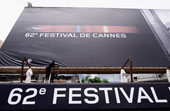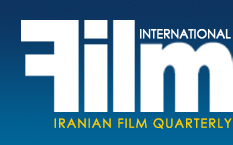|
62nd Cannes Film Festival (France; May 13-24, 2009)
Not the Usual Cannes!
by Mohammad Haqiqat
|
 1. About concerns 1. About concerns
Every January, the eyes of world cinema are riveted on Cannes Festival pushing Berlin Festival, which is held in February, into some oblivion. Enthusiasm of directors, producers and film buyers, on the one hand, and attention paid by international media to this event, on the other hand, is not a secret. One of producers of Jim Jarmusch’s new film, The Limits of Control, was really fed-up when the film was not admitted to the competition section because it was of high financial import to him. As film selection days were closing, there was more concern among those who had sent their films to Cannes. When a film’s chance for screening in Cannes increases, so does its price. Cannes can be rightfully called the most important film market in the world.
Since early 2009, when a great number of famous filmmakers had proposed to send their films to Cannes, other filmmakers were concerned because their chances seemed so dim. A friend sitting on film selection board noted that “with all these great names, it will be easy to launch two festivals this year.” About 1,670 features and 2,602 short films had been sent from 120 countries. At last, 52 films from 32 countries were admitted to the official sections (competition), Un Certain Regard (A Kind of Look), and out-of-competition). Out of those films, 20 were slated for the competition section and the rest were sent to other two sections. About 42 films premiered in Cannes. Some countries which had been actively present in recent years were, more or less, marginalized. Presence of the Latin American and East European cinemas was less pronounced and only few West European and American films were sent to the competition section. Iran had sent more than 30 features including the works of famous, semi-famous, and even new directors. Nobody Knows about the Persian Cats (Bahman Qobadi) was finally accepted. The film, like some other Iranian films, had been shot in a limited time without hue and cry using a digital camera. Filmmakers in various countries are currently using digital facilities to bypass bureaucratic formalities needed to obtain a permit for their films. They make their films and wait to see what happens next. This form of “underground” cinema will finally become “open”. Underground cinema is like water; it will finally gush out to the surface somewhere along its path.
2. About films unfit for competition
Despite all the ballyhoo before the festival, which promised this year’s edition to be something different, it is not difficult to judge that films like Vengeance (Johnnie To); Kinatay/ Butchered (Brillante Mendoza), Enter the Void (Gaspar Noe), Thirst (Park Chan-Wook), Face (Tsai Ming-Liang) and Spring Fever (Lou Ye) were not qualified for the competition section. The last film, which was a Chinese production, was about the wife of one of two leading actors who has doubts about faithfulness of her husband and hires a person to make sure. Some Chinese directors have now learnt how to get awards from western festivals and are trying to aggrandize what is forbidden in their country; in most instances they have achieved their goal. Of course, this is not limited to China and there are many relevant examples.
Park Chan-Wook’s film is about a young Korean priest who gradually devolves into a vampire. Since he is trusted by people, he starts sucking their blood. As the film continues, you see more violence and blood as well as occasional funny scenes. Brillante Mendoza, the Filipino director who is a favorite of the festival’s secretary-general, was also present in last year’s event with Serbis which was not a remarkable film. In Kinatay/ Butchered (joint production by Philippines and France) he focuses on a young student of criminology. Many scenes have been shot at night in Manila. It includes many tedious scenes which challenge viewers’ patience.
Gaspar Noe, the controversial French director, was present in the competition section with Enter the Void (France / Germany/ Italy) after eight years of absence, but his film failed to make up for the absence. He has made an English-speaking film in Japan and has been engrossed with neon lights which light Tokyo at nights. A sister and his brother have been living in Tokyo for a short time. The sister works in nightclubs and the brother is selling drugs. They have lost their parents in childhood due to an accident and love each other. When the police try to nab the brother, he is killed leaving his sister in confusion. The film is totally in English and you can see nothing save for streets lit with colorful neon lights and nightclubs. Even the Japanese are not shown, unless in the background of a few scenes. The film could have been produced inside a décor in France, especially in view of many digital special effects used in it. The problem with the film is that sometimes it avails of brilliant ideas like flying the camera from one scene to another instead of cutting between the two scenes, but the idea is repeated so many times that loses attraction. Or when it wants to explain about childhood of those characters, the scenes and information is repeated many times for no good reason. Perhaps if it were reedited into a one-hour film, it would be a much better work. Gaspar Noe explains the relationship between illicit drugs and death and studies their effect on the brain. The scene in which the leading actor is abusing drugs and experiences melancholic hallucinations takes the viewer into some kind of trance.
SUBSCRIBE
[Page: 104]
|
|
|
|
|
President & Publisher
Massoud Mehrabi
Editors:
Sohrab Soori
Translators:
Sohrab Soori
Behrouz Tourani
Zohreh Khatibi
Saeed Khamoush
Contributors
Shahzad Rahmati
Saeed Ghotbizadeh
Advertisements
Mohammad Mohammadian
Art Director
Babak Kassiri
Ad Designers
Amir Kheirandish
Hossein Kheirandish
Cover Design
Alireza Amakchi
Correspondents
E.Emrani & M. Behraznia (Germany)
Mohammad Haghighat (France)
A. Movahed & M. Amini (Italy)
Robert Richter (Switzerland)
F. Shafaghi (Canada)
B. Pakzad (UAE)
H. Rasti (Japan)
Print Supervisors
Shad-Rang
Noghreh-Abi
Gol-Naghsh
Subscription & Advertising Sales
Address: 10, Sam St., Hafez Ave., TEHRAN, IRAN
Phone: +98 21 66722444
Fax: +98 21 66718871
info@film-magazine.com
Copyright: Film International
© All rights reserved,
2023, Film International
Quarterly Magazine (ISSN 1021-6510)
Editorial Office: 5th Floor, No. 12
Sam St., Hafez Ave., Tehran 11389, Iran
*
All articles represent views of their
authors and not necessarily
those of the editors
|
|
|

